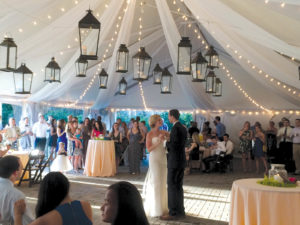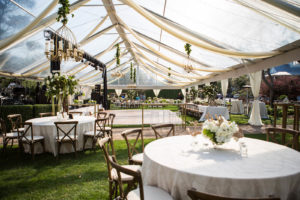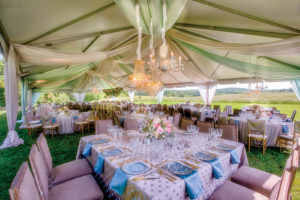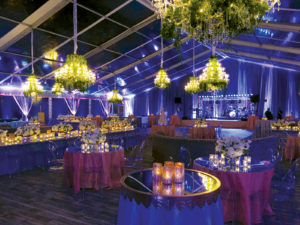
His company’s hometown may be North Carolina’s largest city, site of NASCAR’s Hall of Fame and Bank of America’s headquarters location, but Dan Hooks isn’t too proud to chuckle that “Charlotte is not exactly the hotbed for fashion or cutting-edge style.
“It used to take six months to a year for a trend to get to us,” says the president/CEO of Party Reflections Inc. “With Pinterest and Instagram, it’s instant. Something can be seen in every other market in the country and there’s no behind the curve or out of style anymore, because you see things as they happen.”
Pinterest, in particular, has changed the landscape for many businesses—perhaps no more so than in tent rentals and event planning, especially in the weddings market.
“I think you could call it a game changer in that it has opened people’s eyes to what can be done in a tent. With Pinterest, you can see the gamut from small decor items, up to the most elaborate setups inside a tent,” Hooks says. “I think it has proven what is possible in someone’s backyard.”

“Pinterest has definitely changed the mindset from ‘rain plan’ to focal point of event design for tent rentals,” says Elizabeth Veal, creative director of Beachview Event Rentals & Design in Brunswick, Ga. “The ability to visualize the scale and possible grandeur of a tent enables those planning an event to consider building their own space from scratch rather than making another venue work.”
“The world’s catalog of ideas,” as the photo-database site bills itself, presents businesses with two sides.
“In a good way, it’s easier when clients have a direction,” says Tina Li, owner of Los Angeles, Calif.-based In the Clouds Events, which specializes in weddings. “The bad part is that they want exactly what they see. You end up with a cookie-cutter wedding using the Mason jars and the same types of flowers and backdrops. Couples forget to imprint their own personality and style into the design. I say to them, ‘That’s a great idea, but how do we make it yours?’”

LisaMarie Dwyer, owner of Creative Ambiance Events in West Warwick, R.I., agrees.
“Pinterest causes repetition in the popularity of ideas for events,” she says. “We could be doing four weddings in a weekend and they will all have the same theme, color scheme and elements.”
Dwyer believes that Pinterest’s “idea-a-second” mentality has limited opportunities for “true artists.”
“We are being forced to re-create another person’s idea, simply because the general public overuses Pinterest boards instead of asking a local professional to come up with creative and new ideas,” she says.
Although Pinterest may be the elephant in the room, there are plenty of other party crashers.
“I would lump all social media as a game changer in tent and event rentals. It’s not just Pinterest that is driving clients to be so particular in their vision. It’s also Instagram, Twitter, Facebook, even Snapchat to some degree now. Then there are also the various wedding blogs,” says Davis Richardson, owner of Sugarplum Tent Co. in Boyds, Md. “People planning events are inundated with images. A client can sit in a meeting and search on their phone for a navy blue tented wedding and show us dozens of pictures on the spot of what they want their event to look like.”
“There are so many idea-board-driven sites, like Party Slate and The Knot, that provide anyone planning an event with inspiration,” Veal notes.
Great expectations
The raison d’etre of Pinterest and its cohorts is also the problem they create: picture-perfect inspiration.
“Brides love photos featuring elegant tents and structures with gorgeous interior decor, lighting and florals,” Richardson says.
“Clients will show me things that are really elaborate,” Li concurs, adding, “They have no idea the table linen costs $50 to rent.”
“A Pinterest photo of a centerpiece is generally not obtained from an actual event, but from a photo shoot where three hours has gone into the design and labor and primped perfection of a single centerpiece, which is just not feasible for an event where there are 40 to 50 of them,” Dwyer says. “The ideas shown may take hours beyond our abilities to be cost-effective for the client. Sometimes, procurement of materials or an abundance of needed materials is an issue.”
“Sometimes the difficult part is re-creating a picture format on a large scale. Something may look great in a 15-by-15-foot space, but could be cost-prohibitive to reproduce in a 50-by-100-foot tent,” Hooks says. “Luckily, we have a large volume of our own pictures to help a customer visualize the event. If there’s something their heart is set on, maybe we can do it over one table or the ceremony spot but not the whole tent. Or they may bring us a picture in the daytime and we know their event is at night, so we show them how that might affect their vision.
“A lot of times, the photo they bring is based on a table of 10 and they want to do it for 100, so that completely blows the budget out of the water,” he continues. “One way to approach it is to say, ‘If that’s your vision, give us your budget and we will see how many people we can make that budget work for.’ Another approach would be to take the vision and ask what elements are the most important to them and build off those and see what money is left.”
“Sticker shock is a real concern for anyone who does not have event design experience or someone who has yet to plan a large-scale event,” Veal says. “It is often the details and less glamorous items, like air conditioning in a tent, that add up quickly and are forgotten by those who are focusing on a picture.”

Party Reflections used chandeliers with greenery as a compromise from a Pinterest photo of floral chandeliers with candles. Photo courtesy of Party Reflections Inc.
Turning the tables
“People get ideas from blogs,” Li says. “When they come to me, I ask them, ‘What’s your favorite wedding blog?’”
Despite the lofty expectations inspiration-gathering sites can create, the strategy for event businesses is to spin those sites to their home-court advantage.
“As event designers, we use Pinterest for inspiration and to glean insight into current trends,” Veal says. “We create boards for specific events, ideas for future color schemes, etc., and consider the most frequently searched terms when creating material for our own pins.”
In a 2014 interview for The Atlantic, Pinterest co-founder Evan Sharp referred to the “cycle” in which an individual’s board of pinned objects “also helps other people make their lives.” As grandiose as that sounds, he also called it “a kind of utility.”
“Our sales people have their own Pinterest pages,” Hooks says. “And Party Reflections has an Instagram page. On our website, we get specific with particular items versus an overall look. On the other hand, our Instagram and Facebook pages spotlight our specific locations. Some of those pictures are from customers using our equipment.”
“Instagram is huge right now in the event industry,” Richardson says. “If you are not showcasing your work on Instagram, you are missing out. It’s a big source of referrals for us. Planners see our work and refer people to us with confidence because they see the type of event we deliver.”
While Li notes that she gets clients from posts of her work on blogs and digital magazines, she expands on the concept of sharing.
“I have multiple [Pinterest] boards based on themes and styles,” she says. “I incorporate my own projects, but also those of others, because it provides more inspiration for couples than just being a promotional tool for me.”
Online visual collections also have led tent and event rental companies to grow and work efficiently.
“Photos brought in by clients have prompted us to get into specific lighting and decor, so it has opened our avenues of product development and availability,” Hooks says. “Take lighting, for example. There are plenty of Pinterest and Instagram photos at night with great washes of light. Before, we were dealing in incandescent lights with plugs and electrical cords. You never see cords on Pinterest pages. It led us to using battery-operated LED lights.
“There have been times when we have bought materials that were shown to us in a picture—a different color or fabric or style,” he continues. “And if materials are hung in an interesting way, we can just show it to our installers. In that regard, [Pinterest] has been helpful. It would be harder to draw it on paper.
“We always want to re-create a picture. Anything we can do internally helps us grow too,” Hooks concludes.
“These are the tools people are using. It’s trendy and it’s easy. If we don’t embrace it, if you turn them away, then you are going back to square one,” Li says. “People used to cut out pictures from magazines. Everything is online these days. As professionals, we have to adapt.”
Janice Kleinschmidt is a freelance writer based in San Diego, Calif.
Tips for dealing with the dilemmas posed by picture-perfect
online sources of inspiration:
“Listen and do everything within reason to accommodate your client’s wishes. If you are willing to make concessions, your client will likely follow suit. Be creative. ‘MacGyver’ when you can, and try to hone in on your client’s top priorities so those are delivered first.”
—Elizabeth Veal, Beachview Event Rentals & Design
“Nobody is seeing that Pinterest picture as a comparison to their vision. No one knows that you are not putting lanterns all over the ceiling, because you are creating an event from scratch. Tell your customers to go into planning with the elements they want to create, but to not worry if everything accomplished is not on their wish list. Work with your customers to give them the best possible value they can get and the best possible look they can get based on their budget.”
—Dan Hooks, Party Reflections Inc.
“It’s important to listen to your clients and find out what is most important to them. Quite often, clients show us photos they’ve found online, claiming to love everything pictured. But, digging deeper, you might learn it’s the tent entrance or the lighting or the style of the dance floor that really drew them in. This helps ensure you can provide them with the ambiance they envision at the price point they can afford.”
—Davis Richardson, Sugarplum Tent Co.
“Just really listen to what your clients are looking for, instead of pitching what your own ideas are. Take their personality into consideration. Don’t push what’s uncomfortable for them. Tell them, ‘This is the budget you have, and this is what you can expect.’ And always offer them options in their price point. They may want to splurge on one portion of their wedding and balance the budget somewhere else that’s not as important to them.”
—Tina Li, In the Clouds Events
- Paper items, from flowers to origami
- Serving dishes from sustainable materials
- Fabric swagging in ceilings
- Vintage decor
- Café/bistro lighting
- Pantone’s color of the year (Greenery)
- Mixed metals
- The rustic look
 TEXTILES.ORG
TEXTILES.ORG


